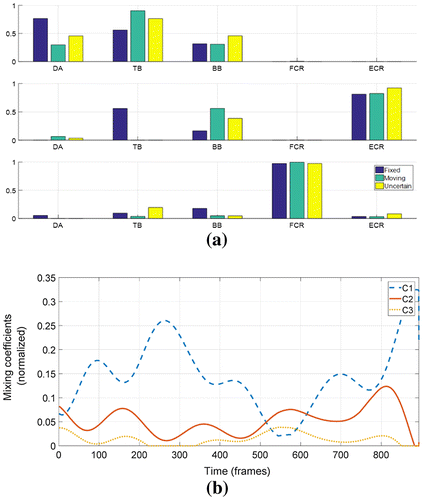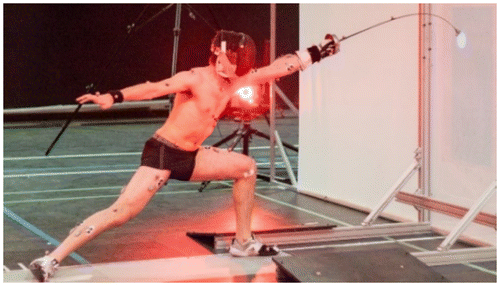 ?Mathematical formulae have been encoded as MathML and are displayed in this HTML version using MathJax in order to improve their display. Uncheck the box to turn MathJax off. This feature requires Javascript. Click on a formula to zoom.
?Mathematical formulae have been encoded as MathML and are displayed in this HTML version using MathJax in order to improve their display. Uncheck the box to turn MathJax off. This feature requires Javascript. Click on a formula to zoom.1. Introduction
Fencing is an Olympic sport composed of three different weapons (foil, sabre and épée), with specific rules and target areas. This open-skilled sport involves high levels of neuromuscular coordination, strength and power. To score against their opponent during attacks, one of the most frequent action used is the lunge. This technical action requires an explosive extension of the trailing leg to perform a forceful move forward of the weapon in order to quickly touch their opponent. During this attack, the fencer makes certain adjustments to change the goal according to the response of the opponent. The complexity of the visual stimulus selection lead to a decrease of the attack performance (Sanderson Citation1983). The impact of the stimulus complexity selection is mainly assessed through the notion of uncertainty (Gutiérrez-Dávila et al. Citation2014), especially the effect of target change during the attack (Gutiérrez-Dávila et al. Citation2013). Adjustments are prone to appear at different descriptive levels of motor control, especially at the muscular level.
The goal of this pilot study is to evaluate the adaptation of the fencer’s muscle synergies during the attack, when visual perturbations occur.
2. Methods
One subject (1m77 tall, weighing 85 kg) performed the following study. The subject is a fencer competing at a regional level. Two force platforms, sampled at 1000 Hz were used to record the vertical and horizontal reaction forces of each fencer’s feet. An optoelectronic motion capture system with 24 cameras set at 250 Hz recorded the marker’s trajectories placed on the fencer’s épée and on the screen in front of him. A plastron representing the opponent’s body was projected on the screen. Surface EMG wireless sensors (Cometa Labs) sampled at 1000 Hz were placed on muscles of each leg (Rectus femoris RF, Tibial anterior TA, Biceps femoris BF, Gastronemius lateralis GL), and on the armed arm (Deltoideus anterior DA, Triceps Brachii TB, Biceps Brachii BB, Forearm flexors and extensors FCR and ECR). Skin was cleaned and prepared and placements were made in accordance with the SENIAM recommendations. All the devices used in this experimentation were synchronised by a custom software. Figure illustrated the overall experimental setup.
After a specific 15 min warm-up, the fencers received instructions for the task and positioned ‘en garde’ with one foot on each plate (as illustrated in Figure ). At the command of ‘ready?’ and after a previous random period ranging from 0.5 to 1.2 s, the target was projected on the plastron and all recording systems were activated. Then, the fencer had to execute a lunge as fast as possible trying to touch the target with the tip of the épée. Three conditions were analysed: Fixed, where the target is fixed during the attack (illustrated by a green colour around the plastron projection). Moving, where the target always change during the attack (in red). Uncertain, where the target could change or not (in blue). Four areas of possible target’s position were proposed and located in each corner of the plastron. Finally, 128 attacks were performed by the subject in a random order. The target change was determinated from the instant at which the horizontal and vertical components of the force from the trailing leg reached a value greater than or equal to 100% of body weight. EMG were processed with the following protocol: DC offset removal, Bandpass filter (5th order 10–450 Hz butterworth bandPass filter), heart rate pollution removal when necessary (Independent Component Analysis - based ECG filter), Rectification, Low pass filter (5th order 6 Hz butterworth low pass filter).
A time-invariant muscle synergy model was used to analyse the muscle activity during the experimentation (Alessandro et al. Citation2013). Time invariant synergies can be represented as follows:
With a M x T muscle activation signals for M muscles during a trial of T time samples, W a M x D synergy matrix of D synergies wi, and C(t) a D x T mixing coefficient matrix.
Muscle synergies were extracted on two subsets (upper limb muscles and lower limb muscles respectively). Non-negative Matrix Factorization (NMF) algorithm was used to extract synergies from the whole concatenated trials. The number of synergies was chosen in relation to the highest change in R² slope (resp. 3 for R² = 0.61, and 2 for R² = 0.56).
3. Results and discussion
A consistent set of synergies was extracted among the whole concatenated trials per condition for the lower and upper limb muscle groups. A set of 3 synergies was extracted for the upper limb whereas a set of 2 synergies was extracted for the lower limb. Figure (a) represents the time-independent synergies extracted for the upper limb.
Figure 2. Upper limb normalized muscular synergies wi (a) and mixing coefficients ci for a sample trial (b).

Since no particular adaptation was detected for the lower limbs, depending on the condition, we do not show the extracted synergies here.
However, we can see slight changes in the way the upper limb was controlled during the lunge.
As shown in Figure (b) synergy 1 is mostly active at the beginning and the end of the motion, synergy 3 in the middle of the lunge, and synergy 2 at the end of the motion (just before touching the target).
The first synergy encapsulated most of the action of the DA, TB and BB muscles, whereas synergies 2 and 3 respectively represented the action of wrist extensors and flexors.
The control of the TB was mostly explained by a sharing between synergies 1 and 2 for fixed targets, whereas most of its activity was explained by synergy 1 only in moving and uncertain conditions.
This adaptation may be due to the fact that TB is an elbow extensor that gives strength to the touch during the lunge. In fixed condition, the subject may have touched with more power whereas he deployed less strength in moving and uncertain conditions to keep a sufficient flexibility to adapt its final position with regard to the target motion. This assumption is also supported by the small increase of the BB activity at the end of the motion in moving and uncertain conditions that may be due to a stabilization behaviour.
4. Conclusions
This pilot study aimed to analysing the adaptation in terms of muscle synergies during fencing lunges. Although small adaptations depending on the fact that the target is moving or not were detected in the way the muscles were activated synergistically, the task was not as discriminant as we expected. The subject did finally found that some of the proposed attacks were very close to match situations, whereas some others were unrealistic. We consider enhancing the protocol in order to be as close as possible to real fencing conditions. However, such a protocol has the potential to investigate deeply the way the human adapts to uncertain conditions, and we aim to proposing this experimentation to a wider audience of fencers with a similar level of skill.
Finally, this kind of experimental setup has also a great potential for training, since numerous match situations can be emulated in an easy way.
Acknowledgements
This work was supported by the ANR project ENTRACTE ANR 13-CORD-002-01.
References
- Alessandro C, Delis I, Nori F, Panzeri S, Berret B. 2013. Muscle synergies in neuroscience and robotics: from input-space to task-space perspectives. Front Comput Neurosci. 7:1–16.
- Gutiérrez-Dávila M, Rojas FJ, Caletti M, Antonio R, Navarro E. 2013. Effect of target change during the simple attack in fencing. J Sports Sci. 31:1100–1111.10.1080/02640414.2013.770908
- Gutiérrez-Dávila M, Zingsem C, Gutiérrez-Cruz C, Javier Giles F, Javier Rojas F. 2014. Effect of uncertainty during the lunge in fencing. J Sports Sci Med. 13:66–72.
- Sanderson FH. 1983. The effect of directional uncertainty on reaction time and movement time in a fencing task. J Sport. 1:105–110.10.1080/02640418308729667

